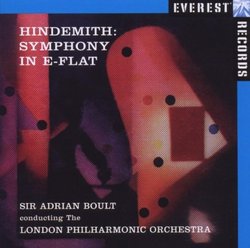| All Artists: Paul Hindemith Title: Hindemith: Symphony in E-Flat Members Wishing: 0 Total Copies: 0 Label: Everest UK Original Release Date: 1/1/2008 Re-Release Date: 5/12/2008 Album Type: Import Genre: Classical Style: Symphonies Number of Discs: 1 SwapaCD Credits: 1 UPC: 5060175190130 |
Search - Paul Hindemith :: Hindemith: Symphony in E-Flat
CD Details |
CD ReviewsBoult's Hindemith symphony revisited by the "new" Everest Larry VanDeSande | Mason, Michigan United States | 06/23/2010 (4 out of 5 stars) "Everest Records from New York owns a sturdy reputation for high end sound in the days before audiophiles littered the musical terrain. Started in Long Island in 1958, Harry Belock set up a prized studio for his recordings, of which this was one. Sir Adrian Boult was known in those days as an English music specialist that dabbled in other repertory. If he had a profile in the music of 20th cenutry German Paul Hindemith (1895-1963) only his friends and confidantes knew of it. Once Black's company released this LP (for long-playing record, as they were called in the 1950s), everyone found out Boult knew something about Hindemith.
This recording is the second CD of this performance, the first coming in the 1990s when the (first) rejuvenated Everest Records unveiled it on CD linked to the Hindemith Violin Concerto Violin Concerto / Symphony in E-Flat. Now, another new Everest Records (this one from England) has released this in America. They've released a few other of their classic issues including Stokowski's Tchaikovsky Francesca Da Rimini / Hamlet and Boult's middle and best version of Ralph Vaughan Williams Job A Masque for Dancing Job / Wasps. Both of those recordings can be found in their earlier Everest CD pressings by searching around Amazon, too. The Hindemith Symphony in E flat is hardly shy to the recording studio. There have been a handful of successful recordings of it, besides this one, including Bernstein's somewhat typically overwrought issue Hindemith: Symphony in E-flat / Symphonic Metamorphoses on Themes of Carl Maria von Weber / Concert Music for String Orchestra and Brass, Op. 50 (Royal Edition) linked to some of the composer's other music. A version by Tortelier is considered more successful Paul Hindemith: Symphony in E flat / Nobilissima Visione, Orchestral Suite / Neues vom Tage Overture. The Boult version is fairly typical for this conductor: big boned, open textured, and anything but circumspect. His straightforward impetus fits the music well. In four movements, the 1940 symphony is fairly typical of what was being written around the world at the time. I hear vestiges of earlier German expressionism and even some of the affect of the American school of Barber, Schuman and Piston. For a composer that came of age in the depressed and angry Germany of the 1920s and 1930s, this symphony projects a fair optimism. Its third movement, labeled Lebbeft, begins as a lament but soon changes to a dance format in double time a devil would enjoy -- thus the "dance macabre" characteristic the booklet describes. The symphony ends "triumphant and defiant," the booklet says, not a message for the new Germany of 1940 that defeated France and occupied Paris since Hindemith was kicked out by the Nazis and, after going to Turkey in 1937, arrived in USA 1940. This was his first composition after becoming a U.S. citizen. Hindemith was more than a composer; he was a musical theorist, a teacher, writer and conversationalist on music, an expert violist that premiered the Walton concerto for that instrument, and a composer of such wide compositional skill and interest that he is generally regarded as the top German composer of the epoch between the wars. Here, Adrian Boult and the London Philharmonic Orchestra deliver a fine version of his Symphony in E flat that can, perhaps, be a springboard to interest in his other music such as the violin or cello concertos, Kleine Kammermusik for Wind Qunitet, the Quartet Op. 3, No. 22 and the neoclassical Mathis der Mahler symphony (taken from an opera of the same) that some consider his greatest masterpiece. My four star rating projects an excellent recording in great sound that should have been mated to something else since the symphony itself is only 29 minutes, makiing it among CDs of least duration I know." |

